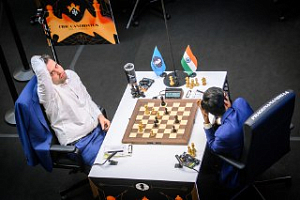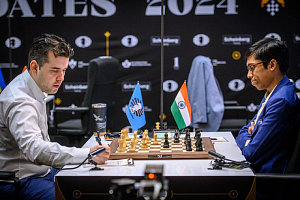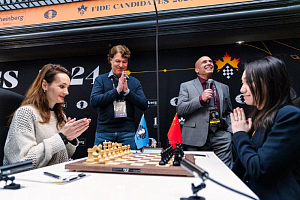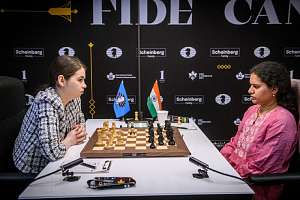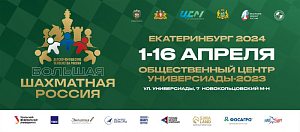11 December 2015
An Apologet of Risk and a Captain of Reliability
Round Two of the Russian Chess Cup in the review of Dmitry Kryakvin.
The second round in the chess capital of Ugra turned out to be no less combative and intense than the first one despite the drastically reduced number of the actors on the scene of action. In the women's section the competition has already arrived at the stage of semi-finals (while it feels like that they have just started playing), which have once again become an ordeal for those who were rated higher. Even though the Russian Champion Aleksandra Goryachkina was at risk of losing both games to Daria Charochkina, she displayed a real courage of a northerner and did not back down under the mighty assailing blows of the Muscovite.
Goryachkina – Charochkina
Game 1
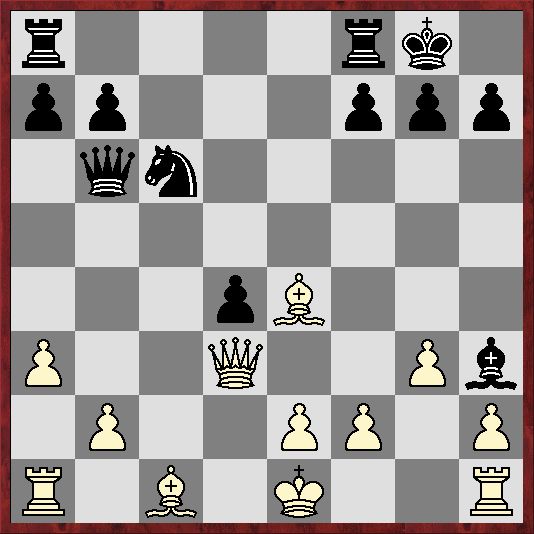
White is far behind in development and her position is not something that you would be especially happy about. 15...Ne5! would have been the most aggressive continuation here, upon which 16.Bxh7+ would have been bad in view of 16...Kh8 17.Qe4 (or 17.Qb1 f5) 17...Rfe8 18.Bf5 Ng6 19.Qd5 (19.Qf3 Qa5+ drops a piece) 19...Re5, depriving White of his poor little bishop. On the other hand, no better than that was 16.Qd1 Rad8 17.Bf4 d3 18.Bxe5 (18.Bxd3 Nxd3+ 19.exd3 Qxb2) 18...d2+, and Black is winning.
15…Rfe8 16.Bf4 Qa5+
Yet another time 16...Ne5! 17.Bxe5 Rxe5 was a pretty decent continuation because 18.Bxh7+ Kh8 19.Be4 fails to 19...Rae8 20.Bf3 Qxb2 21.Rd1 Bg2! and the pressure on the e2-point leads to success. Charochkina tries to press ahead with a rather conceptual plan either, but Aleksandra’ ingenious trick allowed her to avoid an immediate disaster and transfer the game into an ending.
17.Bd2 Qh5 18.f4! Bg4 19.h3 Bxe2 20.Qxe2 Qxe2+ 21.Kxe2 f5 22.Rac1 fxe4
Although the Moscow grandmaster is up a pawn and with connected passers in the ending, the latter are opposed by the king, whereas in the face of an approaching time trouble there is no immediate view of any simple winning plan.
23.Rc5 Rad8 24.Rd1 Rd6 25.Be1 Red8 26.g4 b6 27.Rc4 g5!?
For the sake of the knight’s activation, which is kicking the dirt to assist the advancing infantry, Dasha parted ways with the main achievement of the opening; however, only a dozen moves later the white "wood" would turn into an instrument of counterplay.
28.fxg5 Ne5 29.Rc7 R6d7 30.Rxd7 Rxd7 31.Bf2
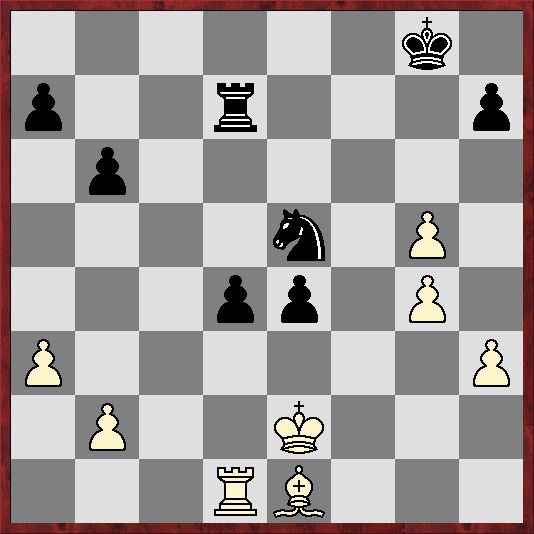
31...Nd3?
After 31...e3 32.Bxe3 dxe3 33.Rxd7 Nxd7 34.Kxe3 Not it is not so clear if the knight will be capable of taking the better of the pawns with so reduced material on the board. For this particular reason, stronger was 31...Nf3! 32.h4 Kf7, paralyzing the white infantry and marching the king over to d5.
32.h4 Nf4+ 33.Ke1 Nd3+ 34.Ke2 Nxf2 35.Kxf2
Savielly Tartakower’s rule about the rook endings being invariably drawish proved true on the first day of the women's semi-finals.
36…Rf7+ 36.Ke2 Rd7 37.Rf1 Rc7 38.Kd2 d3 39.Ke3 Rc2 40.Rf2
The passers are blockaded, while transition into the pawn ending resulted in no more than a draw.
40…Rxf2 41.Kxf2 d2 42.Ke2 e3 43.a4 a5 44.b3 Kf7 45.h5 Ke6 46.g6! hxg6 47.h6 Kf7 48.g5, and the protected passed pawn prevents the black monarch from advancing forward to assist his own passed pawns.
In the return game Charochkina had early opportunities of achieving decisive advantage yet another time.
Charochkina – Goryachkina
Game 2
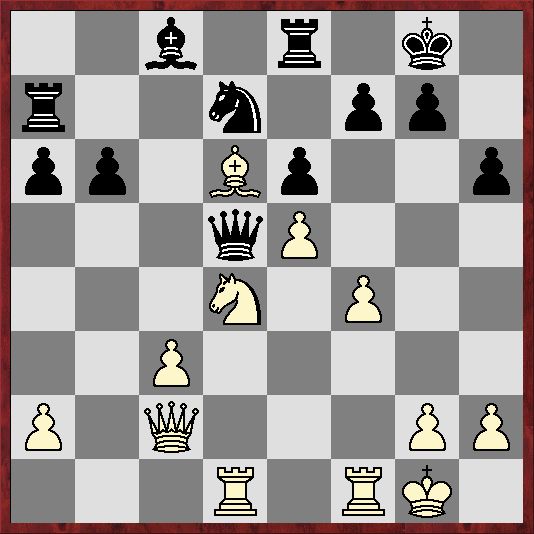
25.f5
This natural continuation of the attack runs into an elegant piece sacrifice. However, another piece move to the same square would have resulted in winning of the exchange and giving rise to a mating assault - 25.Nf5! Further lines are relatively easy to calculate: 25...Qc6 26.Ne7+; 25...Qb7 26.Ne7+ Kh8 27.f5 Nc5 28.f6, and Black will not be able to escape, or 25...Qc4 26.Rd4! Qxf1+ (after 26...Qb5 27.Ne7+ Kh8 28.a4 Qa5 29.Nc6 the queen is lost anyway) 27.Kxf1 exf5 28.Qxf5, winning.
25...Nxe5!!
It comes like a bolt from the blue, and White has nothing better than taking the knight in exchange for three pawns.
26.Nb3
A seemingly spectacular 26.Nxe6?! is in fact a concussion of the air in view of 26...Qa5! 27.Bb4 Qb5 28.a4 Qc4 29.Rf4 Qc6.
26...Qb5 27.a4 Qxa4 28.Bxe5 exf5
Of course, Charochkina had all reason to believe that 29.Nd4 Qxc2 30.Nxc2 Rxe5 31.Rd8+ Kh7 32.Rxc8 can lead to a draw only, but removing the rook from the center allows Black a free hand in having all her forces deployed into action. 30.Rd4! Qb5 31.Bg3 Rae7 32.c4 would be an interesting option, retaining the central footing as well as better chances.
29.Ra1 Qc4 30.Bd4 Rae7 31.Nd2 Qd5 32.Rf2 b5 33.Nf3 Bb7 34.Rd1 Qe4
The black forces are stationed very nicely, but a knight is a knight and, had Daria not hastened with the early trade of queens, such as 35.Bc5! Rc7 36.Bb4 for example, she would have retained her winning chances without having to go into the tie-break.
35.Qxe4? fxe4 36.Ne1 e3, and the passed pawns transformed into a full-fledged force. Soon Aleksandra made use of her opponent’s error in time trouble, forcing her to sacrifice the knight for the passed pawn.
In this match Daria Charochkina lacked a precise finishing blow
In the resulting opposite-colored bishop ending with extra material Goryachkina performed in a precise manner and advanced into the finals. What an enviable self-possession in defense! The Salekhard grandmaster’ opponent became Alina Bivol, who had upset Elmira Mirzoeva on both occasions. However, neither this game managed to dispense with the initiative changing hands back and forth.
Bivol – Mirzoeva
Game 2
1.e4 c5 2.Nf3 Nc6 3.d4 cxd4 4.Nxd4 g6 5.Nc3 Bg7 6.Be3 Nf6 7.f3?

“Lapsus manus” that became known after the chess Olympiad of 1952, in which Alfred Tarnovsky played this move in as many as two games. 7.Bc4 0–0 (7...Qa5 8.0–0) 8.Bb3 would lead to the main lines of the normal or accelerated Dragon.
7...0–0 8.g4
Now 8.Qd2 d5 is insufficient, whereas an attempt of going back to above-mentioned lines with 8.Bc4 lands White in a position after 8...Qb6! 9.Bb3 Nxe4 10.Nd5 Qa5+ 11.c3 Bxd4 12.Bxd4 Nc5, as in Chiba – Sjugirov, 2010, with dubious compensation for the missing pawn. The pawn advance g2-g4 puts Black up against more challenging tasks to have to deal with; this is exactly how Tarnovsky advanced 63 years ago.
8...Qb6 9.Rb1 Nxe4?
Mirzoeva went by the strongest continuation 9...d5! 10.g5 dxe4 11.gxf6 (11.Nf5 Qa5 12.Nxg7 Rd8 13.gxf6 (13.Qe2 Nd5!) 13...Rxd1+ 14.Rxd1 exf3 15.fxe7 Nxe7 16.Ne8 Be6, and the queen is superior to discoordinated minor pieces) 11...Bxf6 12.Nf5 Qa5 13.Nh6+ (13.Ng3 Rd8) 13...Kg7 with a terrific initiative. However, it is not so simple to calculate the above lines.
10.fxe4 Nxd4
Bad is 10...Bxd4 11.Nd5 Qc5 12.b4 Bc3+ 13.Kf2, therefore Elmira made up her mint to part with the exchange.
Elmira Mirzoeva is calculating lines after the Tarnovsky-Bivol move
11.Nd5 Qe6 12.Bg2 Nc6 13.Nc7 Qe5 14.Nxa8 Qb8 15.Nb6 axb6 16.0–0 Qc7 17.c4, and even thought Black is undoubtedly compensated for the damage suffered, in the subsequent game Bivol performed superbly and went on to finally prove that a rook is a strong piece and can prevail over such a powerful blockading knight as well.

The Men's quarterfinals, just as the previous round of the tournament, were associated with rich and interesting struggle. Artyom Timofeev was elegantly defeated by Dmitry Kokarev.
Kokarev – Timofeev
Game 1
1.e4 c5 2.Nf3 d6 3.d4 cxd4 4.Nxd4 Nf6 5.Nc3 g6 6.Be3 Bg7 7.f3 Nc6 8.Qd2 0–0 9.Bc4 Nxd4 10.Bxd4 Be6 11.Bb3 Qa5 12.0–0–0 Rfc8 13.Kb1 b5 14.Rhe1 Bxb3 15.cxb3 b4 16.Bxf6 bxc3 17.Bxc3 Bxc3 18.bxc3 Rxc3 19.Re3
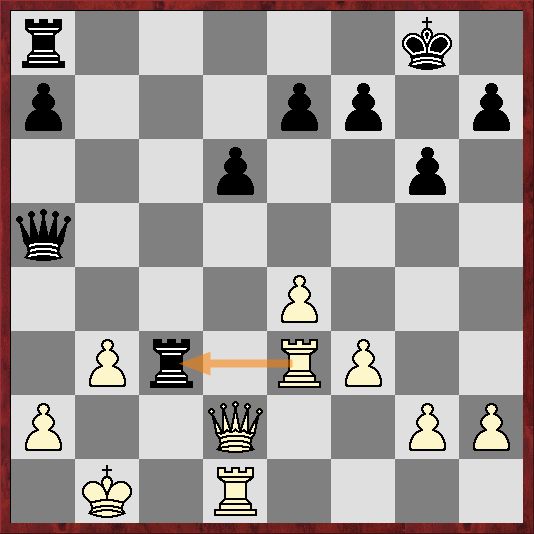
This old line of Averbakh in the Dragon variation has sort of fallen out of limelight recently until the moment when some three or four years ago it became a platform of lively debates between Tatiana Kosintseva and Victoria Cmilyte, who have as many as three games played here already! By the way, instead of 15...b4 Hikaru Nakamura essayed to advocate 15...Rab8.
The rook ending promises superiority to White because of the opportunity of creating a remote passer, therefore long time ago players used to be in favor of transiting into a pawn ending! As evidenced by Adrian Mikhalchishin, in the pre-computer era Black used to hold this position together along the lines demonstrated in one of the correspondence games 19...Rac8 20.Rxc3 Qxc3 21.Qxc3 Rxc3 22.Rc1 Rxc1+ 23.Kxc1 Kf8 24.Kc2 Ke8 25.Kc3 Kd7 26.Kc4 Kc6 27.h4 e6 28.b4 a6 29.a4 h6 30.g4 Kb6 31.f4 Kc7 32.f5 g5 33.h5 Kb6 34.Kd4 Kc6 35.Kc3 Kc7 36.b5 axb5 37.axb5 Kb6 38.fxe6 fxe6 39.Kb4 Kb7 40.Ka5 Ka7 41.b6+ Kb7 42.Kb5 e5 43.Ka5 d5 44.exd5 e4 45.d6 e3 46.d7 e2 47.d8Q e1Q+ 48.Kb5 Qe8+ - stalemate! This whole line was reproduced in the encounter Bukavshin - Belous, 2010.
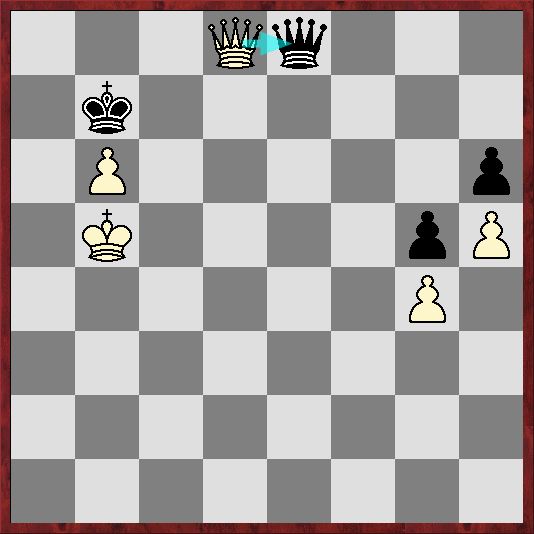
However, in anticipation of another encounter against Victoria, Tanya and Yuri Dokhoian prepared themselves very well by introducing a subtlety 27.b4! a6 28.h4. Kosintseva went on to win easily, although I later chanced to read in one of the comments to the Georgiadis - Janik, 2015 game that Black should keep equality with precise play. The secret proves to be very simple! The Yakovich book dedicated to the Sicilian defense has this ending analyzed by Yuri Rafaelovich up to the forced win! How is that? You just need you buy the book and find it out yourself! The book is definitely worth it.
19…Rc5 20.Qxa5 Rxa5 21.Rd5 Ra6
An engine is a machine devoid of nerves! 21...Rxd5 22.exd5 Kf8 23.Rc3 Rb8 with the idea of 24.Rc7 a5 might seem absolutely hopeless for a human player, whereas “Stockfish” goes straight into this line and accompanies it with an acceptable evaluation.
22.Rb5 Rc6 23.Rb7 Kf8 24.Re2! Rc5!?
This is an ingenious attempt at launching some type of counterplay as opposed to the sour-looking 24...Ke8 25.Rc2!
25.b4 Re5 26.f4 Re6 27.Kc2
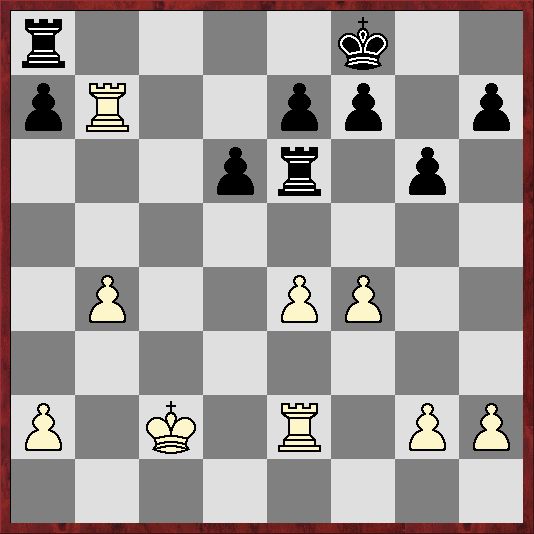
27....a5?
27...d5! 28.e5 (or 28.Kd3 dxe4+ 29.Rxe4 Rd8+ 30.Ke3 Ra6) 28...Rb6 was the last opportunity of putting up some sort of resistance. However, while the poor "Stockfish" evaluated some positions to no more than +0.10, Kokarev and Timofeev evaluated them as lost. While the Kazan grandmaster removs his infantryman from being en prise, he nevertheless helped White in creating a passed pawn that Dmitry went on to queen artistically.
28.b5 d5 29.e5 Rc8+ 30.Kd3 Rc4 31.Rb8+ Kg7 32.Rb2!
The rook supports the passed pawn from behind, just as the book prescribes, while the rest is relatively easy to calculate.
33…Rxf4 33.b6 Rb4 34.Rxb4 axb4 35.Kd4 Kh6 36.Kc5! d4 37.Rd8 Rxe5+ 38.Kc4! Black resigns.
A tremendous achievement by the modern Rubinstein from Penza! Seriously though, Dmitry has handled the ending in a truly textbook style and it should be demonstrated to kids during their classroom studies.
The fierce battle was underway between the men's national team coach and the national team first-timer of this year’s match against China and it was the youth that prevailed in the final run.
Motylev – Fedoseev
Game 1
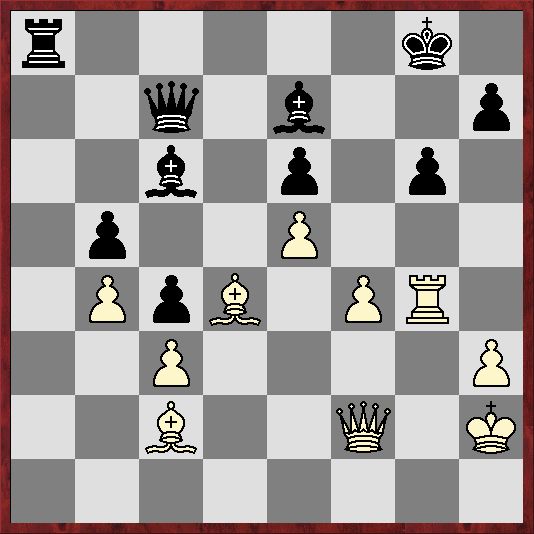
29.Qg1?
A very intriguing way of continuing an offensive was tapped by grandmaster Andrei Deviatkin: 29.Bxg6! hxg6 30.Rxg6+ Kf7 (bad is 30...Kh7 31.Rxe6) 31.f5 Qd8! (losing is 31...Qc8 32.Rxe6 or 31...Ra1 32.fxe6+! Kxg6 33.Qf7+ Kh6 34.Be3+) 32.Be3 Qf8!
It is so unfortunate that this continuation never happened in the game. Motylev is a bright attacking player; on the other hand, when Fedoseev is in shape he is capable of uncovering the most incredible resources, even such as those only queen zigzag moves suggested by the computer. Here Deviatkin came up with a cunny move 33.Bg5, and on my part I would like to mention that a draw can be reached via 33.Rxe6 Bd5 34.Rg6 Qh8 35.e6+ Ke8 36.Qg3 Ra2+ 37.Bf2 Rxf2+ 38.Qxf2 Qe5+ 39.Kg1 Qe4 40.Rg8+ Bf8 41 .Kh2 Qe5+. Also after 33.Bh6 Qh8 34.Rg7+ Ke8 35.fxe6 Qf8 36.Qf7+ Qxf7 37.exf7+ Kd7 38.Rg6 Be4 White will finally regain her piece, but the resulting opposite-colored bishop ending is drawish.
As Vladimir told me, Alexander used to consume a lot of time towards the end of the opening, going into a 45-minute think on one occasion even. He lacked this time when it came to the crucial moment of the game.
29...Kf8 30.h4 Bf3 31.Rg3 Qb7 32.Qb1 Bxh4 33.Rh3 Bd8, Motylev followed up with sacrificing the exchange but could not avoid a defeat.
Vladimir Fedoseev
Thus, Kokarev and Fedoseev were paired against each other in the semi-finals, while another part of the tournament grid saw a lot more tenacious and stubborn type of struggle. Denis Khismatullin performed superbly in his match against Pavel Maletin. Given the fact that Denis is not the most convenient opponent for Pavel (and for whom he would be exactly such an opponent in reality?), it seemed that the outcome of the confrontation was as good as sealed, but the native of Novosibirsk displayed tough resistance and tied both classical games. The tiebreak saw Khismatullin pressing ahead once again, but on falling flags Caissa granted Maletin with a golden chance.
Khismatullin – Maletin
Game 3

The g3-pawn is en prise and Khismatullin defended it in the most natural way.
43.Kh2?
Coming up with calculation of such lines as 43.Kf2!! Qd7 (43...Qa4 44.Ra2!) 44.Ng5 Nc6 45.Rb1 Qd4+ 46.Ke2! Qxe5+ 47.Kd2! Qh8 48.Qg6+! Qg7 49.Qxg7+ Kxg7 50.Rb7 with your flag nearly falling is an extremely challenging task. The king would be in charge of solving the defensive problems himself by going out into the open under attacks with the sole purpose of disallowing the invasion of the enemy’s queen. This is a classy example for the chapter "The feeling of the king." Now Maletin plunges into a counterattack.
The RCF website readers look forward to receiving the feedback from Pavel Maletin about the upcoming Candidates Tournament and the World Championship match!
43...Qf3! 44.Rg1 Qe2+?
44...f4! was so strong after all, plugging the knight into action: 45.Nxf4 (45.gxf4 Qe2+ 46.Kh1 Qf3+ with a draw) 45...Nf5 46.Qf6 Rxg3 - objectively speaking and in accordance with the analysis the position is a draw, but the position is complex with only a few second on the clocks - in a practical rapid game anything could happen. For example: 47.Qd8 + Kh7 48.Qxc7 + Kh6 49.Bc1! Rxg1 50.Kxg1 Qd1+ 51.Kg2 Qxc1 52.Nxe6 Qd2+ 53.Kf3 Qe3+ 54.Kg4 Qf2! 55.Qc6 Ne3+ 56.Kh3 Qf1+ with a perpetual check.
45.Rg2 Qxd3 46.Bxc5!
Alas, the trouble came from the other side, and there was no longer protecting against the array of all possible threats.
46…Rg7 47.Nf4 Qd8 48.Bxe7 Rxe7
48...Qxe7 49.Ng6 Qe8 50.Rd2 Rh7 51.Qg5 loses as well.
49.Qg5+, and following a draw in the return game Khismatullin qualified into the next round.
Denis Khismatullin is a Magister of the Russian Cup tournaments
The next match of Ivan Bukavshin went along the same battle script lines as his encounter with Eliseev - four draws and a subsequent Armageddon. In the evening of his arrival into the fabulous Ugra the author of these lines met Ivan and Vladimir Fedoseev. The native of St. Petersburg became rather passionate in sharing his utmost disappointment about the current tournament in London and the lack of fighting stamina from certain of its participants. I confirmed his point of view by noting that if it was not for Alexander Grischuk with his miraculous saves, the final of the Russian Cup would be by far a lot more meaningful tournament. Having listened attentively to our long tirades about excitement for spectators and countless draws, Bukavshin could no longer maintain his quiet stand and asked: "So, you are blaming me also, aren’t you?" Then, sighing, he started counting all his draws played since the summer of 2015. At this moment Fedoseev’s heart softened and he summed up the discussion by concluding that not losing was a very good strategy indeed.
Sure enough, the "quartet" of games played between Bukavshin and Ildar Khairullin resembled a wrestling confrontation of Alexander Karelin and the American heavyweight in the course of those Olympic Games that used to crown the end of a competitive career for the classic of the Graeco-Roman style. The wrestlers attempted to make a grip on each other, but nothing would come of it for the duration of four games. Finally, the chief referee Mikhail Kriukov, upon having subtracted one minute from Ivan’s playing time, placed Ivan on the ground and demanded that Ildar demonstrate his ground work technique on him.
Khairullin – Bukavshin
Armageddon
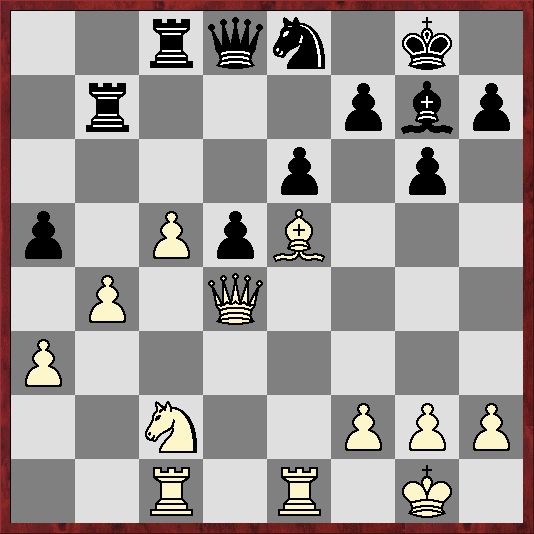
Had Khairullin opted for the logical continuation 26.Bxg7 Nxg7 27.Ne3!, white’s remote passed pawns could have landed him into the battle for the title of the best player among those whose surname starts with the letter "X". However, Ildar treated the position in a rather straightforward fashion.
26.Rb1?! f6! 27.Bg3 e5 28.Qd3 axb4 29.axb4 Qd7 30.Red1 Nc7 31.Ne3 Rcb8 – the central black pawns lock the white bishop out of the game and allow his pieces to comfortably blockade the white passers. Winning such a position from Bukavshin is impossible even in a blitz game, perhaps even more so in a blitz game. The game ended in a draw, thus promoting the Armageddon hero into the next round.
How many more Armageddons is Ivan predestined to play?
So, beginning with round three the correspondent of the Russian Chess Federation website is at the scene of action and it is very soon that we are going to know the name of the first place title-holder. The number one of the Women's Cup will be determined as early as December 10.
















